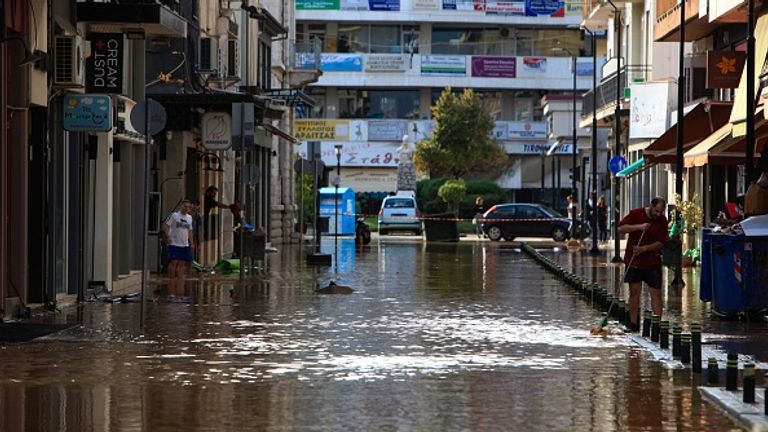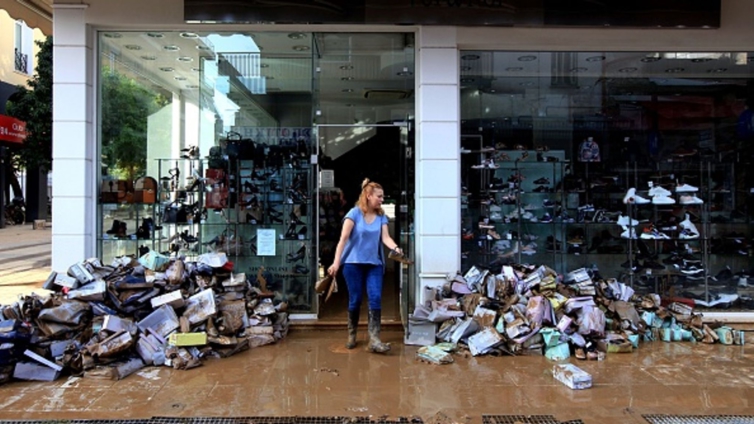
Audio By Carbonatix
Three people have died in Greece after a rare "medicane" storm flooded areas in the centre of the country.
A man's body was found under a collapsed roof near Karditsa, said the Athens News Agency, a day after Storm Ianos flooded houses and swamped fields and roads.
On Saturday, an elderly woman was also found dead in a flooded house in Farsala, and a 63-year-old shepherd was swept away and killed - also in Karditsa.

A search is ongoing for another missing woman.
High winds and torrential rain swamped the Karditsa area - one of Greece's biggest plains - around 125 miles (200km) north of Athens, before moving south on Saturday night to cause more flooding in Crete.
Pictures from near Karditsa showed a medical centre partially collapsed into a swollen river and farmers wading waist-deep to save their animals.
The storm also brought down trees and sunk boats in the Ionian islands on Friday, battering normally idyllic beaches in places such as Zakynthos and Kefalonia and sparking a state of emergency as power was cut.

A clean-up is now under way in Karditsa, where an estimated 5,000 houses were flooded.
Prime Minister Kyriakos Mitsotakis is expected to visit the area in the coming days and has promised economic help.
Greek authorities said they received around 2,500 emergency calls during the storm.
Two people died as Storm ‘Ianos,’ a rare storm known as a Medicane (Mediterranean hurricane), pounded central Greece, flooding streets and homes https://t.co/k1I3uv6lPT pic.twitter.com/tWmrdNwQZR
— Reuters (@Reuters) September 19, 2020
A medicane is a hybrid phenomenon with "some characteristics of a tropical cyclone and others of a mid-latitude storm", according to the UN's World Meteorological Organization.
They have strong winds spinning around a central core and torrential rain, but are smaller in diameter than hurricanes and don't last as long - typically 24 to 48 hours.
Such storms first appeared in Greece in 1995 and, while far less common than hurricanes have become more frequent in recent years.
Latest Stories
-
Uproar as UG fees skyrocket by over 25% for 2025/2026 session
22 minutes -
Japan PM joins fight for more female toilets in parliament
1 hour -
Ga Mantse declares war on fishing industry child labour
2 hours -
Adom FM’s ‘Strictly Highlife’ lights up La Palm with rhythm and nostalgia in unforgettable experience
3 hours -
OMCs slash fuel prices as cedi gains
4 hours -
Around 40 dead in Swiss ski resort bar fire, police say
5 hours -
AFCON 2025: Aubameyang and Nsue make history among oldest goalscorers
6 hours -
Ghana is rising again – Mahama declares
7 hours -
Firefighters subdue blaze at Accra’s Tudu, officials warn of busy fire season ahead
7 hours -
Luv FM’s Family Party In The Park ends in grand style at Rattray park
7 hours -
Mahama targets digital schools, universal healthcare, and food self-sufficiency in 2026
7 hours -
Ghana’s global image boosted by our world-acclaimed reset agenda – Mahama
8 hours -
Full text: Mahama’s New Year message to the nation
8 hours -
The foundation is laid; now we accelerate and expand in 2026 – Mahama
8 hours -
There is no NPP, CPP nor NDC Ghana, only one Ghana – Mahama
8 hours

